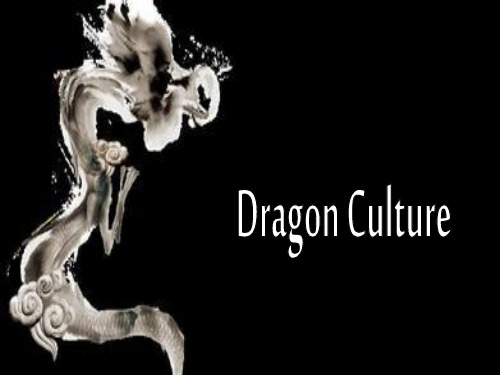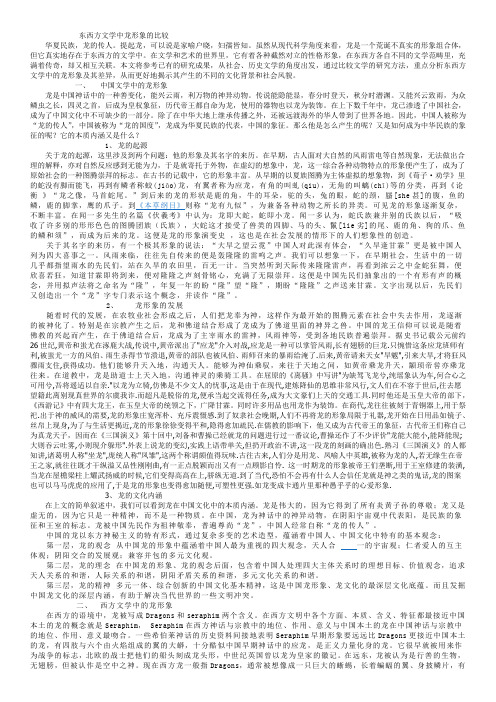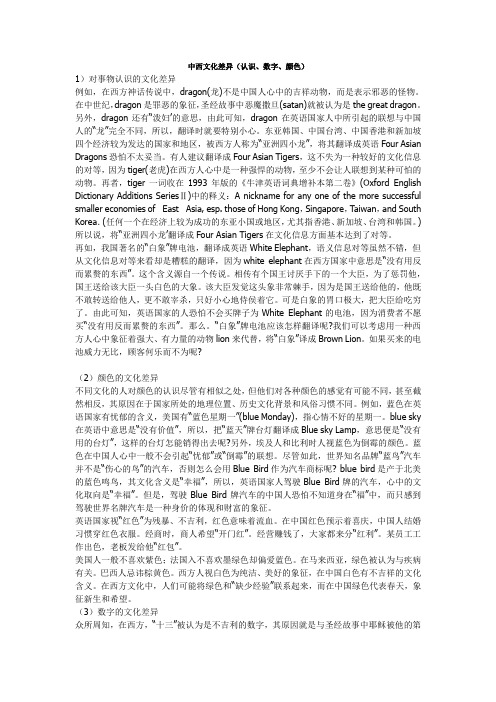中西龙文化差异
- 格式:docx
- 大小:31.63 KB
- 文档页数:13


东西方文学中龙形象的比较华夏民族,龙的传人。
提起龙,可以说是家喻户晓,妇孺皆知。
虽然从现代科学角度来看,龙是一个荒诞不真实的形象组合体,但它真实地存在于东西方的文学中。
在文学和艺术的世界里,它有着各种截然对立的性格形象,在东西方各自不同的文学范畴里,充满着传奇,却又相互关联。
本文将参考已有的研究成果,从社会、历史文学的角度出发,通过比较文学的研究方法,重点分析东西方文学中的龙形象及其差异,从而更好地揭示其产生的不同的文化背景和社会风貌。
一、中国文学中的龙形象龙是中国神话中的一种善变化,能兴云雨,利万物的神异动物。
传说能隐能显,春分时登天,秋分时潜渊。
又能兴云致雨,为众鳞虫之长,四灵之首,后成为皇权象征,历代帝王都自命为龙,使用的器物也以龙为装饰。
在上下数千年中,龙已渗透了中国社会,成为了中国文化中不可缺少的一部分。
除了在中华大地上继承传播之外,还被远渡海外的华人带到了世界各地。
因此,中国人被称为“龙的传人”,中国被称为“龙的国度”,龙成为华夏民族的代表,中国的象征。
那么他是怎么产生的呢?又是如何成为中华民族的象征的呢?它的本质内涵又是什么?1、龙的起源关于龙的起源,这里涉及到两个问题:他的形象及其名字的来历。
在早期,古人面对大自然的风雨雷电等自然现象,无法做出合理的解释,亦对自然反应感到无能为力,于是就寄托于外物,在虚幻的想象中,龙,这一综合各种动物特点的形象便产生了,成为了原始社会的一种图腾崇拜的标志。
在古书的记载中,它的形象丰富。
从早期的以夏族图腾为主体虚拟的想象物,到《荀子·劝学》里的蛇没有脚而能飞,再到有鳞者称蛟(jiāo)龙,有翼者称为应龙,有角的叫虬(qiu),无角的叫螭(chī)等的分类,再到《论衡》“龙之像,马首蛇尾。
”到后来的龙的形状是鹿的角,牛的耳朵,驼的头,兔的眼,蛇的颈,蜃[she甚]的腹,鱼的鳞,鹿的脚掌,鹰的爪子。
到《本草纲目》则称“龙有九似”,为兼备各种动物之所长的异类。

Chinese Traditional Culture 国学, 2023, 11(3), 253-257 Published Online September 2023 in Hans. https:///journal/cnc https:///10.12677/cnc.2023.113040浅析英汉动物词“龙”的差异谢卓融澳门科技大学国际学院,澳门收稿日期:2023年6月28日;录用日期:2023年8月17日;发布日期:2023年8月25日摘要 在中国文化中,龙文化具有重要象征意义,是中国文化的精髓和象征。
在中国文化传统中,以及中国人的认知中,龙是最有生命力的文化符号,无论是它的外在形象,还是它的内在精神,无论是它的文化内涵,还是它的对外功能,都是如此。
就外在形象来说,中国的龙形象代表着神圣、庄严和正义;就它的文化象征来说,中国的龙象征着博大、精深和隽永。
相比之下,西方的龙文化迥然不同。
在西方文化中,龙是邪恶的,是恶人的象征,西方的文化对龙的基调往往是厌恶和屠杀龙。
关键词龙,龙文化,中西文化An Analysis of the Differences between English and Chinese Animal Words “Dragon”Zhuorong XieInternational College, Macau University of Science and Technology, Macau Received: Jun. 28th , 2023; accepted: Aug. 17th , 2023; published: Aug. 25th , 2023AbstractIn Chinese culture, dragon culture has important symbolic significance, and is the essence and symbol of Chinese culture. In the Chinese cultural tradition and the Chinese people’s cognition, the dragon is the most viable cultural symbol, whether it is its external image or its internal spirit, whether it is its cultural connotation or its external function, it’s all so. As far as the external image is concerned, the Chinese dragon image represents sacredness, solemnity and justice; as far as its谢卓融cultural symbol is concerned, the Chinese dragon symbolizes broadness, profoundness and time-lessness. In contrast, the dragon culture in the West is very different. In Western culture, the dra-gon is evil and a symbol of the wicked. The basic tone of Western culture towards the dragon is of-ten to hate and slaughter the dragon.KeywordsDragon, Dragon Culture, Chinese and Western Culture Array Copyright © 2023 by author(s) and Hans Publishers Inc.This work is licensed under the Creative Commons Attribution International License (CC BY 4.0)./licenses/by/4.0/1. 引言龙是中华民族的象征,“龙的传人”是中华儿女的自称,龙是民族自信心的源头。

“龙”在中西文化中的差异探究作者:梁璐茜来源:《中学生英语·外语教学与研究》2016年第07期中西方文化存在着巨大差异。
在各种文化中都有许多各自特有的、包含了本民族文化特色的词和形象。
这些具有特定文化内涵的词在跨文化交际和翻译的过程中都是非常重要的。
不同的文化中有许多各自特有的词和形象,“龙”和“dragon”即是一例。
中国“龙”常被翻译成英文的dragon,然而中国的“龙”和英文的“dragon”在很多方面都是不相同的。
本文试从中西方龙的起源、形象特征、龙的文化内涵三个方面分析“龙”在中西文化中的差异。
一、龙在中西文化中的起源龙的起源问题一直是中国人热衷讨论的话题,到目前为止,我国对龙的起源的说法千奇百怪,至今尚未有定论,但争论主要可归纳为两种。
第一种观点:龙是原始社会时形成的一种图腾崇拜,是综合了多种动物的特征而形成的一种根本不存在的动物,这是最为中国人接受的一种观点。
《辞源》里有“龙是古代传说中的一种善变化能兴云雨利万物的神异动物,为鳞虫之长”的表述;《辞海》里也说“龙是古代传说中一种有鳞有须能兴云作雨的神异动物”。
除此之外,还有许多类似的观点,朱天顺认为“龙是具有很多神性、很神秘的动物神”,“是中国古人幻想出来的动物”;刘志雄和杨静荣则说“龙是出现于中国文化中的一种长身、大口、大多数有角和足的具有莫测变化的世间所没有的神性动物”等等。
大量的生产活动使人们同大自然的接触越来越多,关系也越来越密切。
然而,由于自然界的诸多变化和动物的不可思议的行为对人们产生了巨大冲击,而当时的人类还无法解释这些,于是他们猜测,存在着一个伟大的与“水”相关的“神物”主宰和操纵着这些动物和天象;或者说,这些动物和自然天象是这个“神物”的品性体现。
龙,作为一种对不可思议的自然力的解释,成为人们崇拜的对象就在这时开始了。
经过商、周及战国时期,人们对龙的崇拜到秦汉时已基本成形了。
第二种观点:龙是的确存在的一种动物。

中西文化差异(认识、数字、颜色)1)对事物认识的文化差异例如,在西方神话传说中,dragon(龙)不是中国人心中的吉祥动物,而是表示邪恶的怪物。
在中世纪,dragon是罪恶的象征,圣经故事中恶魔撒旦(satan)就被认为是the great dragon。
另外,dragon还有“泼妇’的意思,由此可知,dragon在英语国家人中所引起的联想与中国人的“龙”完全不同,所以,翻译时就要特别小心。
东亚韩国、中国台湾、中国香港和新加坡四个经济较为发达的国家和地区,被西方人称为“亚洲四小龙”,将其翻译成英语Four Asian Dragons恐怕不太妥当。
有人建议翻译成Four Asian Tigers,这不失为一种较好的文化信息的对等,因为tiger(老虎)在西方人心中是一种强悍的动物,至少不会让人联想到某种可怕的动物。
再者,tiger一词收在1993年版的《牛津英语词典增补本第二卷》(Oxford English Dictionary Additions SeriesⅡ)中的释义:A nickname for any one of the more successful smaller economies of East Asia, esp. those of Hong Kong,Singapore,Taiwan,and South Korea.(任何一个在经济上较为成功的东亚小国或地区,尤其指香港、新加坡、台湾和韩国。
)所以说,将“亚洲四小龙’翻译成Four Asian Tigers在文化信息方面基本达到了对等。
再如,我国著名的“白象”牌电池,翻译成英语White Elephant,语义信息对等虽然不错,但从文化信息对等来看却是糟糕的翻译,因为white elephant在西方国家中意思是“没有用反而累赘的东西”。
这个含义源自一个传说。
相传有个国王讨厌手下的一个大臣,为了惩罚他,国王送给该大臣一头白色的大象。

试谈龙形象在中西文化中的不同意义[摘要]龙是中华民族的图腾,是神圣的象征。
在中国文化中,龙有着重要的地位和影响。
在与西方文化交流的过程中,龙被翻译成“dragon”。
dragon和龙确实具有一些共同特征,它们同是想象中充满传奇色彩的动物,又都在文化中长久地保存下来。
但事实上,中国的龙和西方的dragon几乎是完全不同的动物。
这种对译必然造成文化交流上的误解和障碍。
本文试图从中西方文化中“龙”或“dragon”的不同起源和发展,探索它们在各自文化中的不同象征和意义。
[关键词]龙文化;图腾文化;中西文化[中图分类号]G112 [文献标识码]A [文章编号]1005-3115(2011)020-0057-03龙是中华民族的图腾,是神圣的象征。
在中国文化中,龙有着重要的地位和影响。
从距今7000多年的新石器时代先民们对原始龙的图腾崇拜,到今天人们仍然多以带有“龙”字的成语或典故来形容生活中的美好事物。
上下数千年,龙文化已渗透于中国社会的各个方面,成为一种文化的凝聚和积淀。
龙成了中国的象征、中华民族的象征、中国文化的象征。
对每一个炎黄子孙来说,龙的形象是一种符号、一种意绪、一种血肉相连的情感。
“龙的子孙”、“龙的传人”等称谓,常令我们激动、奋发、自豪。
龙文化除了在中华大地上传播承继外,还被远渡海外的华人带到了世界各地,在世界各国的华人居住区或中国城内,最多和最引人注目的饰物仍然是龙。
因而,“龙的传人”、“龙的国度”也获得了世界的认同。
在与西方文化交流的过程中,“龙”被翻译成“dragon”。
dragon和龙确实具有一些共同特征:都是没有确实考证的传说之物,身躯都很庞大,都能飞翔,外形十分相似。
它们同是想象中充满传奇色彩的动物,又都在文化中长久地保存下来。
但事实上,中国的龙和西方的dragon几乎是完全不同的动物:dragon一词和中国的龙所指不同――正如phoenix和凤凰的强行对译。
这种对译必然造成文化交流上的误解和障碍。
中西文化差异导致的翻译错误注:以下所找案例均为在不了解文化背景情况下直译出现的错误。
动物:1、白象译为WhiteElephant2、龙译为脱离了绝对的邪恶以及凶猛的野兽,更多的则是一种拥有力量的中立生物。
但基督教文化还是西方文化的主流,Dragon在主流文化上还是恶魔的代名词。
凶暴的女人亦被称为“dragon”例如:Sheisarealdragon.(她真是一个母夜叉。
)批评希特勒之类恶魔,政治文章还是称之为Dragon。
在中国龙则是尊贵、威严的象征。
封建社会的皇帝经常自称为“真龙天子”。
还有很多关于龙的成语如:龙凤呈祥、生龙活虎。
3、孔雀译为Peacock中国人认为孔雀开屏是喜庆吉祥的象征,所以人们常用孔雀比喻美丽的人或事物。
但是孔雀在西方的身价却一落千丈。
西方人认为孔雀行走时昂首阔步、目中无人,头冠频频摆动,还不时开屏来炫耀其美丽,这是"骄傲"、"虚荣"的表现。
TheAmericanHeritageDictionary对peacock的骄傲如孔雀4"蝠"crazyasabat发疯havebatsinthebelfry精神失常,行为乖张5、海燕译为Petrel在中国的文化中,海燕是搏击风浪勇敢的象征,但在西方人看了,海燕的出现就预示着暴风雨将要来临。
看见它就联想起“招致灾祸,带来纠纷”。
6、喜鹊译为Magpie在西方文化里,喜鹊的名声不太好。
它寓意着“爱饶舌、爱搬弄是非的人”和“爱储藏零七八碎物品的人”。
这些都属于贬义。
喜鹊由于它单调而又嘹亮的鸣声成为多嘴多舌的象征。
在奥维德的《变形记》中就记载,一位饶舌的妇人变成一只让人歧视的鹊。
但是在中国,喜鹊却象征着好运,人们相信它的叫声表示有好消息和有受欢迎7话中,Owl之说。
owl通8、羊译为羊在中国人的心目中具有吉祥、温顺、文雅、平和的美质,是五谷丰登、人畜两旺、国泰民安的象征。
在中国文化中,“绵羊”和“山羊”都是羊,并没有特殊喻意。
比较文学是一门跨民族、跨语言、跨文化、跨学科的文学研究。
首先,跨民族、跨语言、跨文化、跨学科,这四个方面是对比较文学作为一门学科的总体的全面的概括,而不是指具体的研究实践。
在具体的研究实践中,只要涉及其中的任何一个方面,就进入了比较研究的领域。
跨民族是最根本的,是判断一项研究是不是属于比较文学最基本的标准其次,这四个“跨”具有广泛的意义,既是指比较文学的研究领域,也是指比较文学研究对象一个必备的特性,它把各种跨越性的文学现象放在世界文学的平台上,用一种国际的眼光来分析分析他们之间的关系。
再者,在四个“跨”中,除跨学科外,其余三跨都是互相联系的,而且在内容上有所重叠,但各有所指。
民族文学一般都是以民族语言为媒介所以跨民族的文学往往同事就是跨语言的。
但是一种语言为多个民族使用的情况并不少见,语言的使用范围有时要大于民族的范围,所以跨民族与跨语言又并不相等。
然后,跨文化指跨越文化体系,跨文化不仅意味着超越民族文化,更意味着超越文化体系。
跨民族的文学本身已经包含跨文化的意义,是直指研究对象的研究视角,但是跨民族与跨文化还是有区别的。
中西龙文化的不同摘要:中西方“龙”文化有很大差别,主要表现在不同的龙的起源、不同的象征意义、不同的形象和不同的文化衍生意义。
但中西方龙也有一定的共同点,即不论在世界上任何一种文明里,龙的价值都在于给以人们一个永恒的崇拜和追求对象:对力、对水、对火、对天空的向往,对征服自然界所有不在人类控制之下的力量的渴望。
关键词:龙;起源;象征意义;衍生意义一引言中国有数千年的龙文化,龙成了中国的象征,中华民族的象征,中国文化的象征。
对于每一个炎黄子孙来说,龙的形象是一种符号,一种血肉相连的情感!因而,“龙的传人”、“龙的国度”也获得了世界的认同。
随着全球化进程的不断推进,人类已经进入了多元文化并存的时代,跨文化交际引起人们前所未有的关注。
为了促进跨文化交流,人们开始对中西方龙文化进行比较研究。
浅析中西方龙文化对比本文从网络收集而来,上传到平台为了帮到更多的人,如果您需要使用本文档,请点击下载按钮下载本文档(有偿下载),另外祝您生活愉快,工作顺利,万事如意!一、引言在没有此研究之前,人们很容易的把中国龙和西方的dragon等同起来,认为是种动物。
但是真的是小一样。
西方屠龙历史悠久。
在西方非常受欢迎的动画片《驯龙高手》里就讲到了屠龙,和以龙为坐骑。
故事的主人公是一个叫希卡普的维京少年,他住在博克岛,对抗巨龙是家常便饭。
这个少年的思想很前卫他另类的幽默感也小能讨好他的村落的村民和大家长。
他参加了屠龙训练营,他就觉得这是他证明自己是个屠龙高手的机会。
但是当他遇到并结交了一只受伤的龙,他的人生就完全改变,而原本是希卡普证明自己的机会,却成为改变整个部落的未来的机会。
可见,在西方龙是邪恶的象征,人人都想杀死它。
西方dragon 是一种可怕的怪物,它有长长的尖爪,巨大的翅膀,会游泳会喷火,脾气暴躁。
龙代表了丑陋的黑暗势力,一副恶狠狠的样子,人们向往的是光明。
而在中国,龙是神兽,它能呼风唤雨,无所小能。
在著名的古代小说里,中国民问有四海龙土,在《西游记》中也曾经提过。
即东海龙土、南海龙土、西海龙土、北海龙土。
它能上天入海,能管降雨,为干涸的土地带来雨水。
它是权威的神圣的象征,在古代皇帝被称为真龙天子。
只有皇帝才能使用带有龙图腾的东西,百姓用是要杀头的。
而龙的矫健,高高在天,是人们膜拜的对象。
它有神力,给人们带来吉祥和安宁。
在中西方文化里面,我们简单的把中国龙和西方dragon对等起来是小可取的,会让人们产生文化上的误会。
事实上,中国龙和西方dragon并小是同一种龙。
中国龙是美好的为人们带来祥和的吉祥神物。
而西方dragon却是丑陋黑暗势力的化身,它能飞越万里,能喷火,咬死人类。
人们希望战胜它,差异巨大。
西方龙有很多种类,有黑龙耐萨里奥,红龙阿莱克斯塔萨,绿龙伊瑟拉,黄龙诺兹多姆。
它西方传说中的一种动物,是邪恶的使者。
A Comparative Study of the Dragon Image inWestern and Eastern Culture2013.湖南师范大学英本一班周才贵Abstract:This thesis firstly compares the dragon culture and its historical process respectively in western and eastern countries, then gets the conclusion, although they are both the fake things that come from imagination, but they aren’t(are not )equal. They are with different cultural origination, images and the duties in legends, their symbolized meanings are also different. The dragon in China standsfor the Chinese national spirit and symbols, its cultural content is to some extent from the western dragon. The Chinese dragon is the symbol of mysterious and auspicious. It also stands for the empire right. However, in western countries, dragon stands for greedy and evil; they are considered as the souls that have been dead under the sword of the heroes. Just because of the cultural difference, the western and eastern people find difference in understanding and taking use of the image of dragon. In the communication of the western and eastern world, the Chinese dragon are directly translated into “Dragon”, which c aused the image of the Chinese dragon to be affected, thus, to discuss and research the important role that the dragon plays in western and eastern world while analyzing its effect on their national spirit and cultural life and well master its historical and cultural content will have people to really understand the content of the other culture. This thesis, just start from the historical and cultural origination together with dragon’s imagine and individualisms to analyze the cultural difference of dragon.Keywords:dragon image cultural differenceTable of Contents1. Introduction……….1.1 Background of the study1.2 Purpose and significance of the study……….2. Dragon image.2.1 Image 62.2 Dragon image72.2.1 Symbolic meaning of the Eastern Dragon image.2.2.2 Symbolic meaning of the Western Dragon image.3. Differences between Western and Eastern dragon image (10)3.1 In Poems 103.2 In Legends.113.3 In Festivals114. Reasons of the differences4.14.24.34.45. Conclusion (14)Works Cited.1. Introduction1.1 Background of the studyTo the image of dragon, which doesn’t really exist, the western and eastern worldis maintaining different attitude to it. Thus different legends, stories were given birth to. In China, dragon is the main symbol of luck in the Chinese national culture. The dragon culture originates so far with much content, which reflect the psychological world of the Chinese nation. The Chinese people call themselves the sons of dragon, in festiva l of the dragon boating day, they would dance a “dragon”1, race the dragon boats. There is also fruit in China called “the dragon eye”(just Litchi chine sis), there is also tea called the dragon well tea, uron tea. The tool for dinner can be called dragon dishes or the dragon cup. However, in the western world, dragon is considered as a kind of fierce and attacking giant animal, the symbol of evil. There are many stories or novels describe just like in a castle, there is an evil dragon, the near people should donate it a young girl each month. In movies, there is also giant dragon like Godzilla. Thus, to understand the different dragon culture in western and the eastern world, we can understand different cultural background so as to learn the sense of dragon more clearly.1.2 Purpose and significance of the studyThe purpose of this study is to analyze clearly respectively the sense and meaning of both western and eastern dragon based on cultural difference. With the analysis about this animal that have been familiar with both western and eastern people, we can know better about the cultural difference between different countries. By researching it, we can experience more about the principles and the structure of cultural difference, so that the communication between different countries may to some extent find some helps.Presently, the situation of globalization has been more and more common in the whole word, thus we find the need to know more about each other, the first thing that we should pay attention to is the cultural difference. A good method to achieve this is to find some good examples. The dragon can be considered as the best tool to represent the difference on this aspect; this is also the significance of this study.1This is not really a dragon, just a silk or paper one, which is operated by tens of people to symbolize the luck or the wish toward tomorrow.2. Dragon Image.2.1 ImageThe so called “Image”, is a kind of artistic profile that comes from objective things, added with the special feelings of the creators. To be simple, image is the “profile” that has been added with “senses”, such things is used to show the feelings and thoughts of the creators.2.2 Dragon image2.2.1 Symbolic meaning of the eastern dragon image.In the Chinese legends, dragon is a kind of mysterious animal that can change itself and make winds and rain, which is good to everything, the leader of the nature. It’s a kind of totem, being not living in the living world, because it’s just the combination of many different totems.The formal formation of the Chinese dragon started from the Xia Yu time. When he has strengthened its ruling location in the central plains, he combined the snake and the totems from other races, thus dragon was formed. Dragon was given birth to because of the need to rule a country. In the far ancient times, the race which admired snake was very common; snake has a very strong life force, it met the wish of the primitive peoples’. There was different kind of gods in <Shan Hai Jin>2, many of them were just with the shape and body of snakes and dragon. Take it as the main component of dragon, will show the wish of developing the national and country, so that it can be accepted by each of the races. Dragon is the combination of many different kinds of culture, once it’s formed; it has located its authorized position of symbolizing the Chinese nation. In Chinese ancient empires, the kings are always calling themselves as dragon. The tools like cups or bowls would also be decorated with the shape of dragon, so dragon has already become the symbol of the king rights. Thus, in China, and the whole eastern world, dragon is the symbol of noble, lucky and holy, dragon means the rights that on the society top, the ruler of the country, the dragon is maintaining the force to meet the wish of the people to come across good 2A kind of Chinese ancient literatureweather in the whole year, its mysterious history also give the Chinese dragon culture more attractions.2.2.2 Symbolic meaning of the western dragonThere can be many legends about dragon in western countries; it was in most times described as a fierce and big monster. In the middle centuries, dragon was the symbol of evil, in the bible story, the demon Sadam was just called as the great dragon. In the western hero poems just like the Greek mythologies, Riemann mythologies and north European mythologies, there were all stores about killing dragons.In the views of western people, dragon can be ugly, fierce, releasing smokes and fire which scares people. From below different English dictionaries which have defined dragon we can clearly compare the image of dragon in both western and eastern people.《The Oxford advanced dual explanation dictionary》defines dragon as “a large fierce animal with wings and a long tail,that can breathe out fire”。